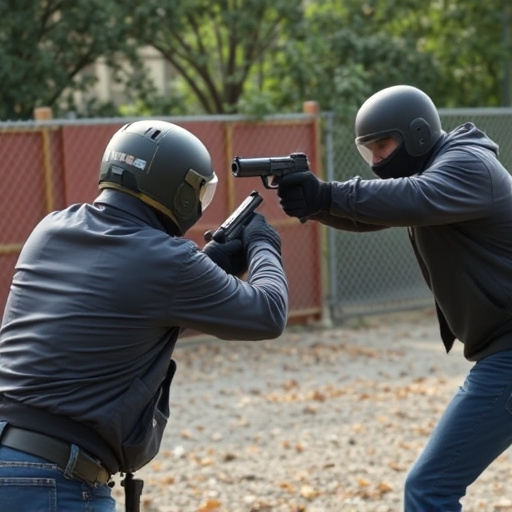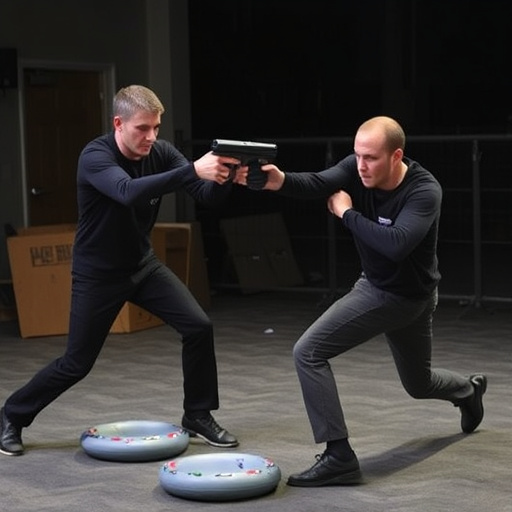Optimizing Stun Gun Electrodes: Spacing for Maximized Effectiveness in Concealed Flashlights
The effectiveness of a concealed stun gun flashlight combo hinges on precise electrode spacing, whic…….
The effectiveness of a concealed stun gun flashlight combo hinges on precise electrode spacing, which optimizes electric current flow for swift immobilization in self-defense situations. This design element balances concealment and power, with compactness prioritizing stealth and wider spacing intensifying the shock. Regular cleaning, inspection, and adherence to manufacturer guidelines are crucial for maintaining optimal electrode spacing, ensuring the device's longevity and reliable performance for personal safety.
“Uncover the critical role of electrode spacing in the effectiveness of a concealed stun gun flashlight combo. This comprehensive guide delves into the intricate details of stun gun technology, focusing on how electrode placement significantly impacts its performance. From understanding the basics to exploring real-world applications, we examine studies and tests that shed light on optimizing electrical flow for maximum impact. Learn best practices for maintenance and safety, ensuring your concealed stun gun flashlight combo remains a reliable tool.”
- Understanding Stun Gun Electrode Spacing: The Basics
- Why Electrode Placement Matters in a Concealed Stun Gun Flashlight Combo
- Optimizing Electrical Flow: Effective Stun Gun Electrode Configuration
- Testing and Studies on Stun Gun Electrode Spacing
- Real-World Applications: What Users Need to Know
- Best Practices for Maintenance and Safety with Electrode Spacing
Understanding Stun Gun Electrode Spacing: The Basics

Understanding Stun Gun Electrode Spacing: The Basics
When it comes to self-defense tools like a concealed stun gun flashlight combo, electrode spacing plays a crucial role in its effectiveness. Electrodes are the points of contact on a stun device that deliver an electric current to incapacitate a threat. Proper electrode spacing ensures that the current flows efficiently through the target’s body, leading to quick and effective immobilization. This is particularly important for stun guns designed for self-defense, as their compact size often means closer quarters when deploying them.
The ideal electrode spacing varies depending on the design of the stun gun and the intended use case. For instance, a concealed stun gun flashlight combo, which combines illumination with shock capabilities, may have electrodes positioned to allow for both functions simultaneously. This dual-purpose design requires precise electrode spacing to deliver an effective electric shock while providing clear lighting during low-light situations. Understanding these fundamentals is key to ensuring the optimal performance and safety of any stun device.
Why Electrode Placement Matters in a Concealed Stun Gun Flashlight Combo

In a concealed stun gun flashlight combo, electrode placement plays a pivotal role in determining its effectiveness. The proximity and arrangement of electrodes directly impact the stun device’s ability to deliver a powerful and safe electric shock. A well-designed combo ensures that the electrodes are strategically positioned to maximize current flow when making contact with a target. This precise placement allows users to disable assailants quickly while also emphasizing the non-lethal nature of the weapon, crucial for self-defense scenarios.
When considering a concealed stun gun flashlight combo, it’s essential to understand that electrode spacing must balance power and concealment. A compact design may offer better stealth, but wider electrode spacing can enhance shock intensity. The ideal arrangement strikes a balance between these factors, ensuring both discreetness and the device’s ability to subdue an attacker effectively. This fine-tuned equilibrium is what sets apart a truly efficient self-defense tool from one that merely looks the part.
Optimizing Electrical Flow: Effective Stun Gun Electrode Configuration

Optimizing Electrical Flow: Effective Stun Gun Electrode Configuration
When it comes to a concealed stun gun flashlight combo, electrode spacing plays a crucial role in its effectiveness. The configuration of electrodes directly impacts the electrical flow delivered to the target, ensuring swift and powerful immobilization. A well-designed electrode setup allows for optimal current distribution, maximizing the stun weapon’s impact without causing excessive damage or collateral harm.
For stun guns with multiple electrodes, proper spacing ensures that the electric field is evenly dispersed across the contact area. This balanced distribution prevents hot spots, which can lead to increased discomfort or even burn marks on the subject. A strategic electrode layout also accommodates various physical attributes and body positions, making the stun gun suitable for self-defense scenarios involving individuals of different sizes and shapes.
Testing and Studies on Stun Gun Electrode Spacing

Testing and studies on stun gun electrode spacing play a crucial role in ensuring the effectiveness of these self-defense devices, especially when incorporated into concealed weapons like a concealed stun gun flashlight combo. Researchers and manufacturers invest significant time and resources to optimize electrode placement for optimal shock delivery. These tests often involve simulating various scenarios to gauge the impact of different electrode arrangements on the stun gun’s performance.
One key aspect researchers focus on is the distance between electrodes, known as spacing. Closer electrode spacing can increase the intensity of the electric current, potentially enhancing stun effectiveness but also raising safety concerns. Studies have shown that the optimal electrode spacing for a stun gun varies based on factors like target size and body type. For instance, a concealed stun gun flashlight combo designed for personal protection might feature closer electrodes to ensure swift and powerful immobilization of an assailant while maintaining user safety through proper training.
Real-World Applications: What Users Need to Know

In real-world applications, understanding the effectiveness of a stun gun’s electrode spacing is crucial for users seeking self-defense options. The concealed stun gun flashlight combo has gained popularity as a versatile and discreet personal safety device. Users often rely on these combinational tools in high-risk situations, such as walking home late at night or facing potential threats while working alone.
The electrode arrangement plays a significant role in the stun gun’s performance. A well-designed combo with optimal electrode spacing ensures maximum electrical current distribution when deployed. This is particularly important for users who need to disable an assailant quickly and effectively, often in tight spaces where mobility is limited. Proper spacing allows for better contact with the target, enhancing the stun effect and ensuring the user’s safety.
Best Practices for Maintenance and Safety with Electrode Spacing

Maintaining optimal electrode spacing in a concealed stun gun flashlight combo is paramount for both effectiveness and user safety. Regular cleaning and inspection are essential practices to ensure the device’s performance remains unparalleled. Users should wipe down the electrodes with a soft, dry cloth after each use to remove any built-up residue or contaminants that could hinder current flow. This simple step significantly extends the lifespan of the stun gun and guarantees its electric charge delivers maximum impact.
When it comes to safety, understanding the combo’s specifications is crucial. Ensure proper electrode spacing by consulting the manufacturer’s guidelines, which typically provide detailed measurements. Maintaining the correct distance between electrodes allows for a controlled discharge of electricity, minimizing the risk of accidental shocks or reduced stun effectiveness. Always store your concealed stun gun flashlight combo in a secure, dry place to prevent damage and maintain its optimal performance.
In conclusion, optimal electrode spacing in a concealed stun gun flashlight combo is key to ensuring maximum effectiveness. Understanding the basics of electrode placement, optimizing electrical flow, and considering real-world applications are essential for users to make informed decisions. Testing and studies have highlighted the importance of proper configuration, and best practices for maintenance and safety further underscore this critical factor. By adhering to these guidelines, users can maximize the impact of their concealed stun gun flashlight combo, ensuring they’re prepared in various situations.


